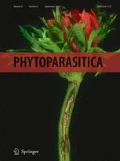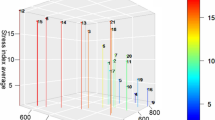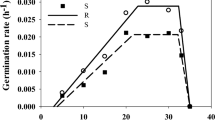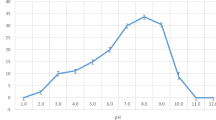Abstract
The re-occurrence of weedy rice in the imidazolinone (IMI) herbicide-tolerant (HT) rice fields in Malaysia suggested that the weed has evaded the IMI herbicide application. This study aimed to evaluate the seed morphological traits as potential escape mechanisms of weedy rice in response to IMI-herbicide (imazapic+imazapyr) treatment. A total of 96 weedy rice samples collected from IMI-HT rice fields were characterized according to seed characteristics. The samples were evaluated for seed dormancy and susceptibility against IMI-herbicide using a standard germination test. Herbicide-induced germination test recorded a high germination (61.99–74.43%) despite strong initial dormancy (9.09–13.14%), indicating potential dormancy breaking by the herbicide. A total of 64.7% of weedy rice morphotypes displayed high seedlings survival (>10%) after herbicide treatment suggesting variation in potential IMI-resistance of weedy rice. Correlation analysis demonstrated the herbicide responses were associated with various seed adaptive traits, especially on pericarp colour (r = 0.3701), hull colour (r = −0.2457), seed dormancy (r = 0.4351), and shattering capability (r = −0.3110). This study demonstrated that seed morphological and physiological characteristics have a significant correlation with resistance towards IMI-herbicide. Resistant genes might be linked with these weedy traits as part of the adaptive mechanism for weedy rice through consequential conferment of the genes from HT-rice into weedy rice.




Similar content being viewed by others
References
Baki, B. B. (2010). Shaping the future of weed science to serve humanity in the Asia-Pacific. Pakistan Journal of Weed Science Research, 16(2), 123–138.
Barret, R. D. H., & Schluter, D. (2007). Adaptation from standing genetic variation. Trends in Ecology and Evolution, 23, 38–44.
Burgos, N. R., Singh, V., Tseng, T. M., Black, H., Young, N. D., Huang, Z., & Caicedo, A. L. (2014). The impact of herbicide-resistant rice technology on phenotypic diversity and population structure of United States weedy rice. Plant Physiology, 166(3), 1208–1220.
Busconi, M., Rossi, D., Lorenzoni, C., Baldi, G., & Fogher, C. (2012). Spread of herbicide-resistant weedy rice (red rice, Oryza sativa L.) after 5 years of Clearfield rice cultivation in Italy. Plant Biology, 14, 751–759.
Bzour, M., Zuki, F. M., & Mispan, M. S. (2020). Evaluation of the emergence of imidazolinone resistant weedy rice (Oryza sativa L.) in Malaysia. Applied Ecology and Environmental Research, 18(5), 7189–7199.
Dilipkumar, M., Burgos, N. R., Chuah, T. S., & Ismail, S. (2018). Cross-resistance to imazapic and imazapyr in a weedy rice (Oryza sativa) biotype found in Malaysia. Planta Daninha, v36, e018182239.
Engku, A. K., Norida, M., Juraimi, A. S., Rafii, M. Y., Abdullah, S. N. A., & Alam, M. A. (2016). Gene flow from Clearfield® rice to weedy rice under field conditions. Plant Soil Environment, 62, 16–22.
Furukawa, T., Maekawa, M., Oki, T., Suda, I., Iida, S., Shimada, H., Takamure, I., & Kadowaki, K. (2007). The Rc and Rd genes are involved in proanthocyanidin synthesis in rice pericarp. Plant Journal, 49, 91–102.
Gealy, D. R., Mitten, D. H., & Rutger, J. N. (2003). Gene flow between red rice (Oryza sativa) and herbicide-resistant rice (O. sativa): Implications for weed management. Weed Technology, 17, 627–645.
Gienapp, P., Teplitsky, C., Alho, J. S., Mills, A., & Merila, J. (2008). Climate change and evolution: Disentangling environmental and genetic responses. Molecular Ecology, 17, 167–178.
Gross, B. L., & Olsen, K. M. (2009). Evolutionary genomics of weedy rice. In C. N. Stewart Jr. (Ed.), Weedy and invasive plant genomics (pp. 83–89). Blackwell Publishing.
Heap I (2022) International Survey of Herbicide Resistant Weeds. http://www.weedscience.org/In.asp. Accessed April 22, 2022.
Jaafar, N. F., Juraimi, A. S., Ahmad-Hamdani, M. S., Uddin, M. K., & Man, A. (2014). Distribution of weedy rice escape variants in Clearfield rice production system. Research on Crops, 15(4), 754–762.
Kuk, Y. I., Burgos, N. R., & Shivrain, V. K. (2008). Natural tolerance to imazethapyr in red rice (Oryza sativa). Weed Science, 56, 1–11.
Londo, J. P., Chiang, Y. C., Hung, K. H., Chiang, T. Y., & Schaal, B. A. (2006). Phylogeography of Asian wild rice (Oryza rufipogon) reveals multiple independent domestication of cultivated rice (Oryza sativa). PNAS, 103, 9578–9583.
Mahmod, I. F., Saiman, M. Z., Mohamed, Z., Ishak, M. N., & Mispan, M. S. (2021). Morphological variation, distribution and relationship of weedy rice (Oryza sativa L.) in peninsular Malaysia. Weed Biology and Management, 21, 86–99.
Mispan, M. S., Zhang, L., Feng, J., & Gu, X. Y. (2013). Quantitative trait locus and haplotype analyses of wild and crop-mimic traits in us weedy rice. G3: Genes genomes. Genetics, 3(6), 1049–1059.
Mispan, M. S., Bzoor, M., Mahmod, I., MD-Akhir, A. H., & Zulrushdi, A. (2019). Managing weedy rice (Oryza sativa L.) in Malaysia: Challenges and ways forward. Journal for Research in Weed Science, 2, 149–167.
Neve, P., Vila-Aiub, M., & Roux, F. (2009). Evolutionary-thinking in agricultural weed management. New Phytologist, 184, 783–793.
Novoplansky, A. (2009). Picking battles wisely: Plant behavior under competition. Plant, Cell and Environment, 32, 726–741.
Peters, J. (2000). Tetrazolium testing handbook: Contribution no. 29 to the handbook on seed testing. Association of Official Seed Analysts.
Pipatpongpinyo, W., Korkmaz, U., Wu, H., Kena, A., Ye, H., Feng, J., & Gu, X. Y. (2020). Assembling seed dormancy genes into a system identified their effects on seedbank longevity in weedy rice. Heredity, 124, 135–145.
Rosas, J. E., Bonnecarrere, V., & De Vida, F. P. (2014). One-step, codominent detection of imidazolinone resistance mutations in weedy rice (Oryza sativa L). Electronic Journal of Biotechnology, 17, 95–101.
Sales, M. A., Shivrain, V. K., Burgos, N. R., & Kuk, Y. I. (2008). Amino acid substitutions in the acetolactate synthase gene of red rice (Oryza sativa) confer resistance to imazethapyr. Weed Science, 56, 485–489.
SAS Institute. (2011). SAS/STAT® 9.3 User’s guide. SAS Institute Inc..
Shivrain, V. K., Burgos, N. R., Gealy, D. R., Moldenhauer, K. A. K., & Baquireza, C. J. (2008). Maximum outcrossing rate and genetic compatibility between red rice (Oryza sativa) biotypes and Clearfield™ rice. Weed Science, 56, 807–813.
Song, B. K., Chuah, T. S., Tam, S. M., & Olsen, K. M. (2014). Malaysian weedy rice shows its true stripes: wild oryza and elite rice cultivars shape agricultural weed evolution in Southeast Asia. Molecular Ecology, 23, 5003–5017.
Sudianto, E., Song, B.-K., Neik, T.-X., Saldain, N. E., Scott, R. C., & Burgos, N. R. (2013). Clearfield® rice: Its development, success, and key challenges on a global perspective. Crop Protection, 49, 40–51.
Sudianto, E., Neik, T. X., Tam, S. M., Chuah, T. S., Idris, A. A., Olsen, K. M., & Song, B. K. (2016). Morphology of Malaysian weedy rice (Oryza sativa): diversity, origin and implications for weed management. Weed Science, 64, 501–512.
Sweeney, M. T., Thomson, M. J., Pfeil, B. E., & McCouch, S. R. (2006). Caught red-handed: Rc encodes a basic helix-loop-helix protein conditioning red pericarp in rice. Plant Cell, 18, 283–294.
Thurber, C. S., Reagon, M., Gross, B. L., Olsen, K. M., Jia, Y., & Caicedo, A. L. (2010). Molecular evolution of shattering loci in U.S. weedy rice. Molecular Ecology, 19, 3271–3284.
Acknowledgements
This research was supported by the Fundamental Research Grant Scheme (FRGS), Ministry of Education, Malaysia (Grant no. FRGS/1/2015/SG03/UM/02/3). This study is part of an M.Sc. dissertation of Amalia Qistina Zulrushdi.
Author information
Authors and Affiliations
Contributions
All authors contributed to the study conception and design. Material preparation, data collection and analysis were performed by Amalia Qistina Zulrushdi, Intan Filzah Mahmod, Muhammad Nazri Ishak, Nur Ardiyana Rejab and Muhamad Shakirin Mispan. The first draft of the manuscript was written by Amalia Qistina Zulrushdi, and all authors commented on previous versions of the manuscript. All authors read and approved the final manuscript.
Corresponding author
Ethics declarations
Competing interests
The authors have no relevant financial or non-financial interests to disclose.
Conflict of interest
The authors declare no conflict of interest.
Additional information
Publisher’s note
Springer Nature remains neutral with regard to jurisdictional claims in published maps and institutional affiliations.
Rights and permissions
Springer Nature or its licensor holds exclusive rights to this article under a publishing agreement with the author(s) or other rightsholder(s); author self-archiving of the accepted manuscript version of this article is solely governed by the terms of such publishing agreement and applicable law.
About this article
Cite this article
Zulrushdi, A.Q., Rejab, N.A., Mahmod, I.F. et al. Seed morphological traits associated with weedy rice escaped from imazapic+imazapyr herbicide treatment. Phytoparasitica 50, 1123–1132 (2022). https://doi.org/10.1007/s12600-022-01021-2
Received:
Accepted:
Published:
Issue Date:
DOI: https://doi.org/10.1007/s12600-022-01021-2




